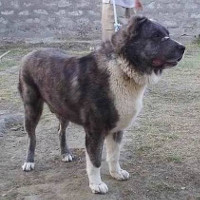 |
Aryan Molossus |
|
He is not recognized by the F.C.I. |
Origin |
Afghanistan | |
Translation |
Francis Vandersteen | |
This breed is also known as |
Mazari Fighting Dog
|
| The ancient Aryan Molossus is closely related to the Sage Koochee and old Persian mastiffs, as well as to other Central Asian dogs, but it is a pure and distinct Afghan breed, probably older than the rest of its relatives. An excellent watchdog and guardian, this remarkably powerful mastiff is most often employed as a fighting dog, used to settle various disputes between villagers, who respect the result of the match as the final judgment. If there is a quarrel between tribes and settlements, each side brings its own dog to represent them in the fighting ring. In this way, problems are resolved without loss of life. The Mazari fighting dog is a very rare breed today, seen only in the mountainous regions of Afghanistan, where they were taken during the Soviet occupation, because the Russians systematically destroyed aggressive native dogs. While Asal blood has made its way into other types of Central Asian shepherd breeds, namely the Kooche and Alabai variants, the breed itself is kept pure and isolated from other dogs, and the bloodlines are maintained and guarded jealously. the few Mazarii families who tend to exchange dogs with each other, rarely, if ever, sell their dogs to foreigners. In some ways closer to Caucasian dogs than to the CAO breed, the powerful Asal is an athletic, muscular Molosser that is extremely aggressive towards other dogs and intolerant of strangers. Because of its vicious nature, it is managed only by its owner, or an expert village dog. The large-headed, bony Choura Khurasani has a strong, lean body, with long legs and a deep chest, somewhat similar to a wolf. The ears are usually cropped and the tail can either be docked or left unchanged, with naturally short-tailed dogs being the most prized and considered the only purebreds by breed enthusiasts. The Masariff Mazarii has a very dense, medium-length coat, generally uniform gray-brown, reddish-brown, fawn, white or brindle. White markings are acceptable on muzzle, feet and chest, as are darker patches on white dogs. Females, which only come into heat once a year, are much smaller than males, whose average height is around 81 centimeters, although some specimens can reach up to 89 centimeters at the withers. |






 English (United Kingdom)
English (United Kingdom)